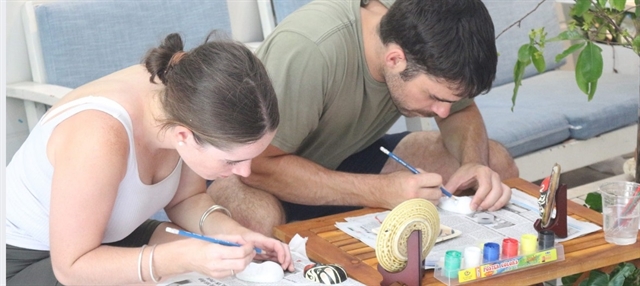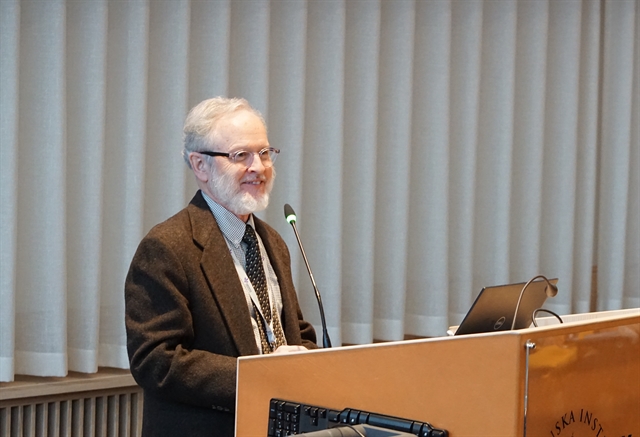 Society
Society

On the sidelines of the 4th Annual Abbott Nutrition Health Institute Global Growth Summit held last week in Stockholm, Sweden, Dr. Robert Murray, Professor of Human Nutrition from the College of Education and Human Ecology, Ohio State University, speaks to Việt Nam News reporter Thanh Hải about challenges and measures to eliminate malnutrition in Việt Nam and around the world.

|
| Dr. Robert Murray, Professor of Human Nutrition from the College of Education and Human Ecology, Ohio State University. — VNS Photo Thanh Hải |
International health experts and scientists focused discussions on how to tackle malnutrition for children at risk and in hospital at the 4th Annual Abbott Nutrition Health Institute Global Growth Summit held last week in Stockholm, Sweden. On the sidelines of the summit, Dr. Robert Murray, Professor of Human Nutrition from the College of Education and Human Ecology, Ohio State University, speaks to Việt Nam News reporter Thanh Hải about challenges and measures to eliminate malnutrition in Việt Nam and around the world.
What is the goal of the summit?
In the past, when we started the Global Growth Summit, it was very much about teaching doctors the latest information about bone growth and tissue growth. And as we've gone through now to the fourth Growth Summit, this is the growth summit where we're talking about how to do the measurements, how to assess risk in the hospital, how to measure mid-upper arms because it's so easy and fast. This is the first time we're really asking the doctors now to go back and try to implement some of these things through their paediatric societies. The goal this time, I think, and my personal goal is every paediatrician in the world uses these tools to hit those two groups – children at risk and children in the hospital. If we could fix those two, we can really achieve the goal of the WHO, which is almost to eliminate childhood malnutrition, including underweight, overweight and stunting.
Could you speak more about hidden hunger and its impact on growth?
Hidden hunger is a little different from being overweight and underweight. Hidden hunger is the group of people who may not be either overweight or underweight but whose diet is poor.
In the US, we have some kids who are underweight, other kids who are overweight, and then we have a group of kids with hidden hunger. By measurements, they look okay, but the quality of their diet is poor. And as a result of that they'll get individual nutrients and vitamins and minerals that are not adequate. A common one for us is calcium and vitamin D. Around the world it's vitamin A, zinc, iron and iodine. Those are very common micronutrient deficiencies.
The challenge for Việt Nam is really apparent if you look at the history in Việt Nam. Going back just the last 25 years, in the 1990s, Việt Nam had a lot of problems with under-nutrition. Malnutrition is poor growth, and underweight and stunting were at very high levels. Since then, Việt Nam has done a spectacular job, because their economy got better dramatically. And their public health efforts were very strong, they've managed to cut malnutrition by a huge margin and started to cut stunting pretty effectively. That's reflected a lot in many different factors. As you raise the economics of the country, there'll be a move from rural areas with poor-quality diets and little opportunity to urban areas with better access to high-quality food, more technology, more jobs, and that's what's happened in Việt Nam. So, HCM City and Hà Nội, they have gotten bigger and the rural areas have gotten less. You'll see the biggest changes in underweight and stunting and malnutrition happening in those cities. The places out in the rural areas still have that same level of underweight and stunting in Việt Nam.
The story that you see in Việt Nam, moving economics coming up, moving to the urban area, better nutrition in urban areas, better education, better situation for mothers and pregnant females. That has cut hidden hunger as well. So, their diet quality is better. And you'll see the same thing in China and Thailand, even in Africa, to a lesser extent.
In the US, we deal with those three things – overweight, underweight and hidden hunger – in different ratios. But we still deal with all three of them. Every country in the world deals with all of them. It is a global issue. Two billion people are facing problems with hidden hunger. But it is children that take the worst of it. You know, it's the most harmful for a child because the brain is growing, the body is growing, and they need all those nutrients. If you make them iodine or iron deficient, they're going to really have problems for life.
Do you have recommendations for developing countries like Việt Nam?
If adolescent females’ diets and family planning were better, so not teen pregnancy, not frequent babies crammed next to each other. If their own nutrition and health was a priority, then they get the baby to the level of birth in the best condition you can possibly get.
At birth, we want that baby to have breastfeeding exclusively and want them to be in a stimulating environment with the best nutrition. Where we see trouble in Việt Nam is where they step away from breastfeeding. In some cities with wealthy families, that's great nutrition. In other areas with poverty, that's really poor quality. And that leads to wasting, stunting and hidden hunger.
So, I want healthy teenage girls, I want strong, well-nourished and well-treated mothers during pregnancy. And then I want breastfeeding exclusively and, after breastfeeding, I want that child to step off into a very high-quality nutrition.
There are two groups I really think that we can make an enormous difference all around the world but in places like Việt Nam particularly. One is if you can identify risk of malnutrition for the child, but not yet malnourished, treat them aggressively and don't let them fall.
The second group is the kids in the hospital when we bring them into the hospital. That kid is at risk of malnutrition – the longer they stay, the bigger their risk. So, one of the things we're talking about at the Growth Summit is screening. And then the longer they stay in the hospital, screening them again and again and again. And as they start to fall, you know, use your nutritional tools right then and stop it. — VNS









